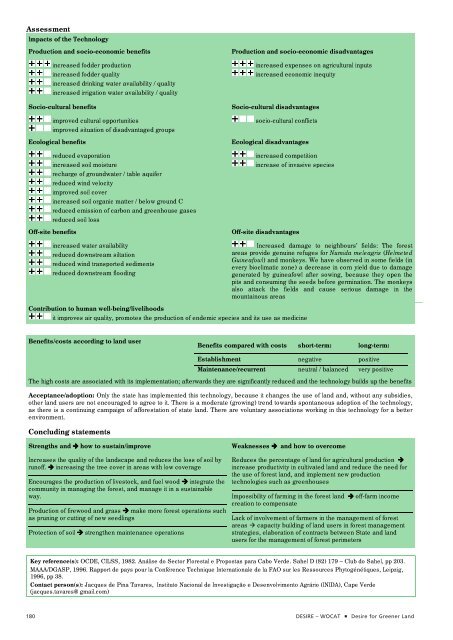Desire for Greener Land
Desire for Greener Land
Desire for Greener Land
You also want an ePaper? Increase the reach of your titles
YUMPU automatically turns print PDFs into web optimized ePapers that Google loves.
Assessment<br />
Impacts of the Technology<br />
Production and socio-economic benefits Production and socio-economic disadvantages<br />
increased fodder production<br />
increased fodder quality<br />
increased drinking water availability / quality<br />
increased irrigation water availability / quality<br />
increased expenses on agricultural inputs<br />
increased economic inequity<br />
Socio-cultural benefits Socio-cultural disadvantages<br />
improved cultural opportunities<br />
improved situation of disadvantaged groups<br />
socio-cultural conflicts<br />
Ecological benefits Ecological disadvantages<br />
reduced evaporation<br />
increased soil moisture<br />
recharge of groundwater / table aquifer<br />
reduced wind velocity<br />
improved soil cover<br />
increased soil organic matter / below ground C<br />
reduced emission of carbon and greenhouse gases<br />
reduced soil loss<br />
increased competition<br />
increase of invasive species<br />
Off-site benefits Off-site disadvantages<br />
increased water availability<br />
reduced downstream siltation<br />
reduced wind transported sediments<br />
reduced downstream flooding<br />
Contribution to human well-being/livelihoods<br />
it improves air quality, promotes the production of endemic species and its use as medicine<br />
Benefits/costs according to land user<br />
Increased damage to neighbours’ fields: The <strong>for</strong>est<br />
areas provide genuine refuges <strong>for</strong> Numida meleagris (Helmeted<br />
Guineafowl) and monkeys. We have observed in some fields (in<br />
every bioclimatic zone) a decrease in corn yield due to damage<br />
generated by guineafowl after sowing, because they open the<br />
pits and consuming the seeds be<strong>for</strong>e germination. The monkeys<br />
also attack the fields and cause serious damage in the<br />
mountainous areas<br />
Benefits compared with costs short-term: long-term:<br />
Establishment negative positive<br />
Maintenance/recurrent neutral / balanced very positive<br />
The high costs are associated with its implementation; afterwards they are significantly reduced and the technology builds up the benefits<br />
Acceptance/adoption: Only the state has implemented this technology, because it changes the use of land and, without any subsidies,<br />
other land users are not encouraged to agree to it. There is a moderate (growing) trend towards spontaneous adoption of the technology,<br />
as there is a continuing campaign of af<strong>for</strong>estation of state land. There are voluntary associations working in this technology <strong>for</strong> a better<br />
environment.<br />
Concluding statements<br />
Strengths and how to sustain/improve Weaknesses and how to overcome<br />
Increases the quality of the landscape and reduces the loss of soil by<br />
runoff. increasing the tree cover in areas with low coverage<br />
Encourages the production of livestock, and fuel wood integrate the<br />
community in managing the <strong>for</strong>est, and manage it in a sustainable<br />
way.<br />
Production of firewood and grass make more <strong>for</strong>est operations such<br />
as pruning or cutting of new seedlings<br />
Protection of soil strengthen maintenance operations<br />
Reduces the percentage of land <strong>for</strong> agricultural production <br />
increase productivity in cultivated land and reduce the need <strong>for</strong><br />
the use of <strong>for</strong>est land, and implement new production<br />
technologies such as greenhouses<br />
Impossibility of farming in the <strong>for</strong>est land off-farm income<br />
creation to compensate<br />
Lack of involvement of farmers in the management of <strong>for</strong>est<br />
areas capacity building of land users in <strong>for</strong>est management<br />
strategies, elaboration of contracts between State and land<br />
users <strong>for</strong> the management of <strong>for</strong>est perimeters<br />
Key reference(s): OCDE, CILSS, 1982. Análise do Sector Florestal e Propostas para Cabo Verde. Sahel D (82) 179 – Club do Sahel, pp 203.<br />
MAAA/DGASP, 1996. Rapport de pays pour la Conférence Technique Internationale de la FAO sur les Ressources Phytogénétiques, Leipzig,<br />
1996, pp 38.<br />
Contact person(s): Jacques de Pina Tavares, Instituto Nacional de Investigação e Desenvolvimento Agrário (INIDA), Cape Verde<br />
(jacques.tavares@gmail.com)<br />
180 DESIRE – WOCAT <strong>Desire</strong> <strong>for</strong> <strong>Greener</strong> <strong>Land</strong>









